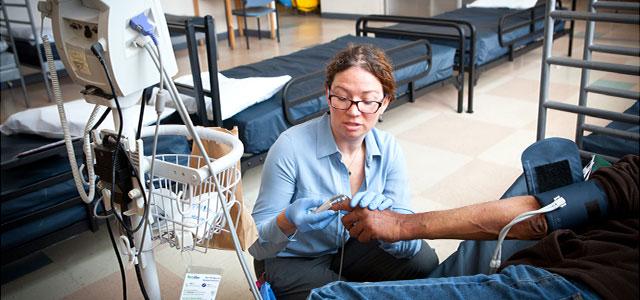
Shannon Smith-Bernardin at the San Francisco Department of Public Health’s Medical Respite and Sobering Center (photos by Elisabeth Fall)
Commentary: Chronic Public Intoxication – Framing the Alcohol Policy Debate
On the streets of San Francisco, the toll of alcoholism on both the individual and society is brutally apparent. According to various publications, including one from the Substance Abuse and Mental Health Services Administration, a majority of chronically homeless people experience alcohol dependency in their lifetime. Yet despite its considerable population of homeless people, San Francisco has the highest number of alcohol outlets per capita in California, with one off-sale outlet (that is, a store that sells alcohol to be consumed off the premises, such as a corner grocery store) for every 200 citizens.
The human cost is staggering, but so are the costs to society, both on the collective psyche and in real dollars. In 2010, an independent analysis by the Lewin Group found that alcohol-related health expenses cost the City and County of San Francisco over $18 million annually. The San Francisco Department of Public Health has also calculated costs upwards of $20 million annually incurred by fewer than 500 alcohol-dependent individuals.
The problem, of course, is not San Francisco’s alone. In fact, alcohol abuse and dependence is a significant societal dilemma, and has always been detrimental to individual health and community well-being. According to the Centers for Disease Control, in 2006 excessive alcohol use was the third-leading contributor to preventable death in the United States, and the cause of over 80,000 deaths. Internationally, the World Health Organization has attributed nearly 3.7 percent of all deaths and 5 percent of deaths under the age of 60 to alcohol.
One of the most debated questions within the policy realm is what to do about these staggering statistics. Are there interventions and policies that can effectively decrease the individual and societal disease burden? And if so, the question is why few, if any, substantial and effective policy solutions have been proposed or enacted, despite evidence of successful interventions to decrease consumption and the harms that follow.
The Nature of the Debate Is Part of the Problem
In the United States, since the repeal of Prohibition in 1933, discussions about how to decrease alcohol’s disease burden have largely focused on the individual drinkers themselves. The result is that the responsibility for alcohol-related complications rests primarily on the individual rather than society.
Fundamentally, individuals play a significant role in the choices they make and some responsibility is appropriate. Except in this case, a focus on individual responsibility largely ignores the roles of society and the alcohol industry when considering the consequences of alcohol consumption, including the public health burden. And this focus on individual responsibility has been only marginally effective at addressing the damage related to alcohol. Framing the entire debate around the individual has allowed the community at large to abdicate its influential role and has enabled the alcohol industry to avoid the negative associations of peddling a highly addictive and potentially dangerous product.
 An alternative framework – one that has been shown in some cases to decrease alcohol-related harm – is that alcohol itself is a risky substance and requires more regulation and oversight in how it is distributed, marketed and generally made available to individuals and communities.
An alternative framework – one that has been shown in some cases to decrease alcohol-related harm – is that alcohol itself is a risky substance and requires more regulation and oversight in how it is distributed, marketed and generally made available to individuals and communities.
This framework interprets alcohol disorders as the consequence of cultural and societal factors that include capitalism and marketing, environment and community, poverty and disenfranchisement. It leads to the idea that efforts to avert alcohol-related harms to both individuals and societies should be aimed at the levels of alcohol availability and consumption. By reframing the debate in this way, we change it from being about morally deficient people to being about the effects of targeting specific individuals and communities with alcohol marketing. This new framework requires the alcohol industry to be accountable for the harmful effects that result from the consumption of alcohol. At its core, this approach works to address alcohol disorders by moderating the availability of and uses for alcohol.
There is significant research that finds a direct relationship between restricting availability – such as raising the minimum price of alcohol, limiting the density of outlets where people can buy alcohol and drink it elsewhere (off-sale outlets) or limiting days and times of sales – and a decrease in alcohol consumption and the subsequent harms. Equally important, communities can directly decrease alcohol-related traffic fatalities by restricting alcohol marketing targeted at youth and increasing taxes on beer.
This reframing of the alcohol policy discussion will not be easy. One huge consequence of Prohibition is that modern efforts at modifying or restricting alcohol sales and consumption tend to be beset by comparisons to that failure now nearly a century in the past. Moreover, changes to alcohol policy affect a multitude of powerful and well-heeled stakeholders, including many who favor keeping the focus on the individual alone.
Nevertheless, failing to reframe the debate ignores the facts. Consider again that San Francisco, with its clearly documented alcohol-related public health burden, boasts the highest number of alcohol outlets per capita in California, with one off-sale outlet for every 200 citizens. That’s no coincidence – and that’s why health officials should prioritize and reframe the conversation on alcohol policy.
An innovative public health perspective could ease the burden of alcohol use disorders from individual shoulders by appropriately sharing that burden with the greater society and alcohol industry that have encouraged and perpetuated this devastating addiction. The reframing may take years of effort, but it is more than the right thing to do: it is the path to finally and significantly reducing the burden of alcohol on individuals, their families and society. We need to revisit the manner in which alcohol is marketed, sold and distributed in order to effectively tackle the significant negative effects of alcohol consumption.
Shannon Smith-Bernardin is a sobering center expert at the San Francisco Department of Public Health’s Medical Respite and Sobering Center, a doctoral student at UC San Francisco School of Nursing and winner of the 14th Annual Ann Klobas Award for Outstanding Policy Paper from the School’s Department of Social and Behavioral Sciences. For a complete set of references for the statistics in this paper, contact Shannon directly at [email protected].



